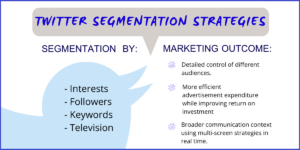When it comes to marketing segmentation, social media allows marketers to take a more detailed control of different audiences. Twitter segmentation strategies, give brands the mechanisms to target marketing budgets more efficiently while improving return on investment.
Moreover, Twitter user segmentation helps to convey ads to consumers in a broader context using multi-screen strategies in real time. Some of the unique Twitter segmentation tools are:
Twitter Segmentation by interests
This Twitter market segmentation feature allows brands to connect with people based on their preferences. For instance, brands can segment person’s interests in Twitter in a comprehensive range of topics from sports and beauty to subtopics such as college basketball or skin care.
Twitter Segmentation by followers
Brands can use Twitter to direct their marketing campaigns to users who follow particular brands @usernames or others similar to those @username followers. For example, brands can target @usernames of influencers who lead the voice of companies in Twitter and target specific messages to them.
Twitter Segmentation by keywords
Twitter keyword segmentation in chronology help to link brands with customers based on the keywords of their latest Tweets or those with whom they have interacted. Hence, search keyword segmentation allows brands to reach consumers who search for a certain phrase or term.
For instance, someone tweets that he/she needs caffeine: @CoffeeBarista, a famous coffee brand segmentation strategy use words like “caffeine”, “latte” and “pick me up”. Therefore, the user who tweeted that he/she needed caffeine could have that Promoted Tweet by @CoffeeBarista in his/her chronology.
Twitter television segmentation
Twitter is the digital mirror of television audiences’ favorite shows. For example, 85% of Twitter users go to the social network during primetime television shows and interact about their favorite programs.
Thus, with Twitter television segmentation, brands can lead certain audiences in relation to specific channels, or programs that fit the brand communications and marketing goals.
If a brand cannot buy advertising within a specific television program, they can reach the same audience on Twitter by creating detailed program content.
Moreover, television segmentation combined with Twitter segmentation strategies help to amplify the brand impact and to connect with viewers in real times. Similarly, brands can develop strategic integrations in relation to major sports events or sponsorships.
Twitter segmentation strategies support the creation and delivery of dynamic personalized content, such features can help Twitter to improve its financial performance and help the company to become a profitable enterprise.


